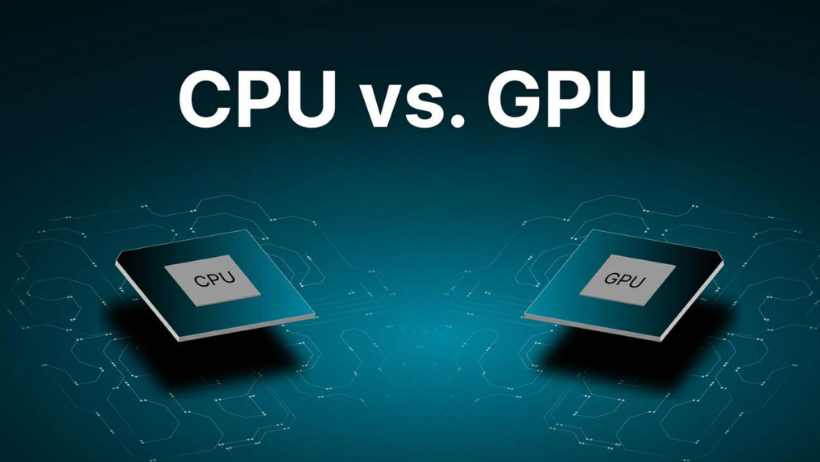When it comes to computing, two components often dominate discussions: the CPU (Central Processing Unit) and the GPU (Graphics Processing Unit). Both play critical roles in your computer’s performance, but they serve different purposes. Understanding the differences between CPU vs GPU can help you make better hardware choices.
In this guide, we’ll break down the functions, advantages, and differences between CPU and GPU. We’ll also explain how each one impacts your computer’s overall performance. By the end, you’ll have a clear understanding of which to prioritize based on your needs.

What is a CPU?
The CPU, often called the “brain” of the computer, is responsible for processing most tasks. It executes instructions from programs and ensures your system runs smoothly.
Key Functions of a CPU:
- Task Management: The CPU runs applications and coordinates tasks.
- Control: It directs data flow between components like memory, storage, and input/output devices.
- Sequential Processing: CPUs are best at tasks that need quick, sequential processing.
CPUs handle general computing tasks. They are designed with fewer cores but optimized for single-threaded tasks.
What is a GPU?
The GPU is a specialized processor for rendering graphics and parallel processing tasks. It handles graphics, video processing, and complex calculations.
Key Functions of a GPU:
- Graphics Rendering: The GPU processes images and video, creating visual outputs.
- Parallel Processing: It handles multiple tasks at once, making it ideal for large-scale computations.
- Accelerated Computing: The GPU speeds up intensive tasks like deep learning and simulations.
GPUs are designed with thousands of smaller cores that excel at parallel processing. This makes them powerful for graphics and data-heavy tasks.
CPU vs GPU: Key Differences
While both the CPU and GPU are essential for a computer’s performance, they differ significantly in purpose and design.
1. Architecture:
- CPU: Has fewer, more powerful cores optimized for sequential tasks.
- GPU: Contains thousands of smaller cores designed for parallel processing.
2. Performance:
- CPU: Handles general tasks efficiently, excelling in single-threaded applications.
- GPU: Performs better for tasks requiring parallel processing, like 3D rendering and video editing.
3. Task Specialization:
- CPU: Manages day-to-day computing tasks like running operating systems and general applications.
- GPU: Focuses on graphics and data-heavy applications like gaming and machine learning.
When to Use CPU vs GPU
Both CPU and GPU are necessary, but which one you use depends on your needs.
Use the CPU for:
- General tasks: Browsing the web, using office software, or managing files.
- Single-threaded tasks: Running older applications or light multitasking.
- Operating systems: The CPU controls the system processes and task execution.
Use the GPU for:
- Gaming: For rendering high-quality graphics and improving gameplay.
- Video editing: It speeds up rendering and enhances playback in video software.
- Data-intensive tasks: Machine learning, AI, and deep learning benefit from GPU acceleration.
Which is Better: CPU or GPU?
The answer to “CPU vs GPU” depends on your needs. For basic tasks like browsing or running office software, a strong CPU will be sufficient. However, for gaming, video editing, or computational tasks, a GPU is crucial for better performance.
Ultimately, both the CPU and GPU are essential. They work best when used together. A powerful CPU handles general tasks, while the GPU excels at graphics and parallel processing.
>>> Read more: AMD or Intel for 3D Rendering? Key Differences
Optimizing Your Computer’s Performance with the Right Balance
To maximize performance, you need a balanced CPU and GPU combination. For gaming or professional 3D rendering, both components are important. The CPU handles system processes, while the GPU powers graphics-heavy tasks like real-time rendering.
A balanced system allows each processor to handle what it does best, ensuring smooth multitasking and performance.
Conclusion
In the CPU vs GPU debate, there’s no one-size-fits-all answer. Both are vital to your computer’s performance but serve different functions. Understanding the differences between CPU and GPU can help you choose the right hardware for your needs, whether you’re gaming, creating, or analyzing data.
For those seeking faster rendering times or greater performance, consider 3S Cloud Render Farm. With 3S Cloud Render Farm, you can offload heavy rendering tasks to powerful cloud servers, speeding up workflows and delivering high-quality results.